
Client
Varlė is among the largest multi-category internet shops in Lithuania. The branded assortment emphasizes household appliances and electronics. A vast diversity of product categories varies from adult stuff to foods and heaters. The company operates as ‘bricks-and-clicks’ retailer with a countrywide delivery options.
Task
→ Enlarge the Return on Advertising Spend (ROAS).
→ Automize processes in the client’s Google Ads account.
Spoiler
eCommerce presents a rather specific business in Lithuania. Domestic advertisers cannot post trade ads even as beta-version. The restriction has disabled Shopping Campaigns, as one of the most effective Google Ads tools to promote such a huge retail market player as Varlė.
Hence, to cope with the client’s task to grow ROAS, we deployed all the available optimization tools.
Eventually, the solution enlarged the client’s ROAS by over 1000% (excl. branded campaigns).
Project Name:
Surge ROAS by 1000%: Six Steps To Google Ads Account Optimization for a Large eCommerce Store
Client:
varle.lt
Our Role:
PPC Management Services
Input Data
We started working with the brand in March 2022. By then, the client had held an active Google account and operated Google Analytics with extensive e-commerce options.
While analytics worked well and provided actual data, the client’s Google Ads account was outdated and lacked automation. The client managed all optimization processes manually and deployed only standard search tools and unsegmented Dynamic Search Ads (DSAs). As a result, the account settings could not help the client leverage sales as the channel’s strategic goal.
Solution
To designate the strategy for ad campaigns’ activity, we have audited the client’s account and analyzed its closest competitors for the available assortment. The obtained data indicated major weaknesses in the client’s Google Ads account and its growth potential.
Setting Up Automation Processes
Given that the client’s account lacked automation for certain types of ads, as a proper solution we used all the available tools to
- Create a Google Ads script that automatically suspended ad groups of the product items marked as ‘out_of_stock;’
- Optimize standard search with responsive search ads (RSAs);
- Optimize the client’s branded campaign;
- Segment Dynamic Search Ad (DSA) campaigns;
- Transfer to the automated bidding strategies;
- Launch Google Performance Max;
- Set up dynamic re-marketing.
The case shows how each tool contributed to the client’s ROAS growth.
Setting The Script For The Items Marked As ‘Out of Stock’
At the beginning of the Project, classic search campaigns worked on more than 100,000 products from the site’s assortment. A special feature was that the availability of goods changed almost every hour.
Products that were not in stock were issued, which did not bring sales to the site and desired purchases to users. The budget was spent inappropriately, while it could have been used for actual positions.
Since checking the status of all products manually is a task more fantastic than real, a Google Ads script was written to automate this process.
ALGORITHM SCRIPT


The Script implementation enabled us to target the client’s ad campaign to the most relevant product items.
Optimizing Standard Search Campaigns
While responsive search ads (RSAs) have proven among the most effective tools for brand promotion, we implemented a range of optimization-driven tech works.
1.Optimizing Logic in Ad Group Creation
→ Problem
- Non-logical formation of ad groups:
– keywords in a broad sense;
– insufficient set of negative words;
– intersection of search requests by different groups of ads;
– an incomplete set of possible keywords.
The Logic of Ad Group Formation before the Start of the Project
1 group – 1 product item – 1-2 key queries in broad relevance to the modifier.
→ Solution
We:
- Suspended irrelevant ad groups that did not show results as per impressions and search queries.
- Processed and extended the keyword list.
- Added the lists of negative words.
- Empowered key queries with the proper types of relevance (i.e. phrasal, exact) to enhance the relevance of incoming traffic.
2.Working with Ads
→ Problems
- 95% of the ads in the account were in the “Expanded Text Ads” format, which had already gone out of circulation and had an ineffective structure.
Ad Structure before the Start of the Project:
1-2 titles (product model and brand) out of the three possible +
One description with a brief outline
Absence of unique selling propositions (USPs) and not mentioning Varle’s brand name in ads.
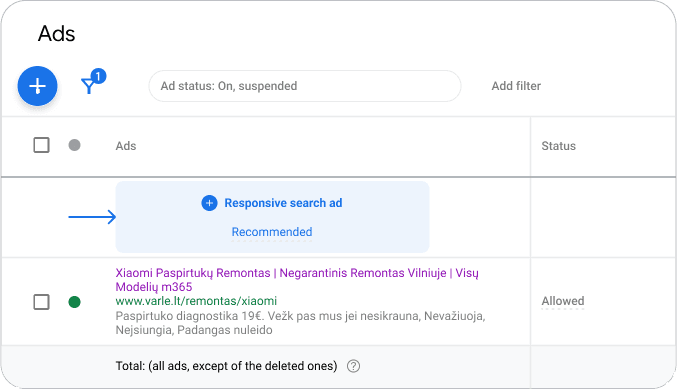
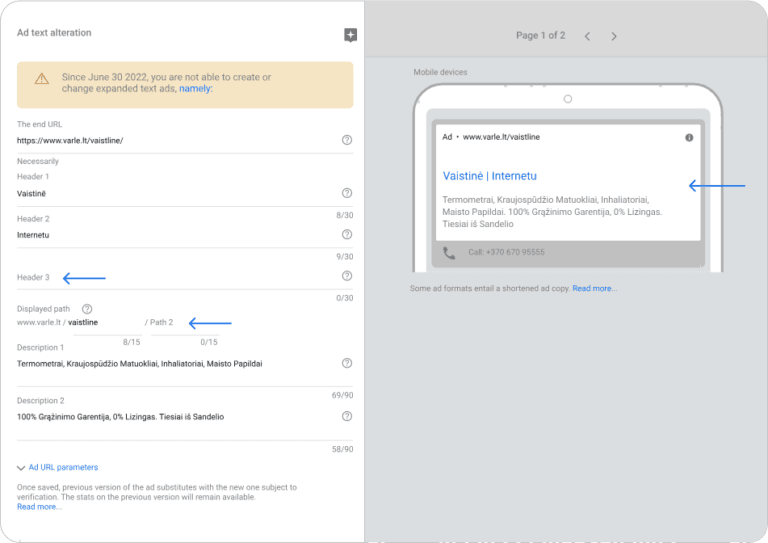

→ Solutions
We:
- Substituted expanded text ads (ETAs) with responsive search ads (RSAs).
- Worked out ad texts (titles and descriptions) by having added targeted unique selling propositions (USPs) and branded content.
- Added dynamic insertion into titles and arranged header positions to always show important information to users.
3. Creating Ad Extentions
→ Problem
- Among the client’s ad extensions, we spotted only a few links and additional information.
- The client was unable to add visual extensions while its account violated Google Ads Policies (i.e. refuted ads and invalid URLs among others).

Blocking the client’s visual extensions
→ Solution
- We fixed violations in “Google Manager”.
- We added actual extensions with images of the product category and images of actual items for narrower areas. This made it possible to display ads in search almost like shopping ads, which are not available in the country.
1 Ad group – 1 product – visual extensions
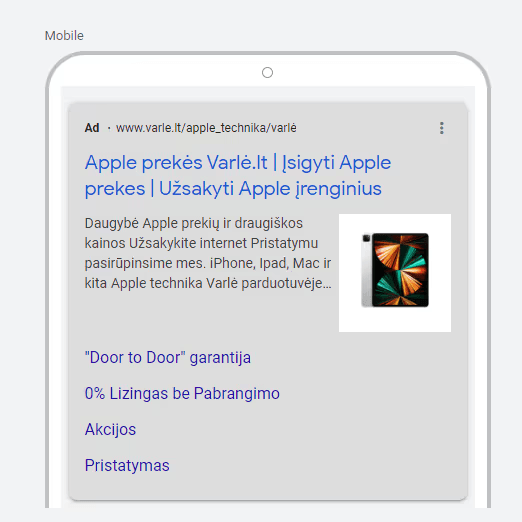
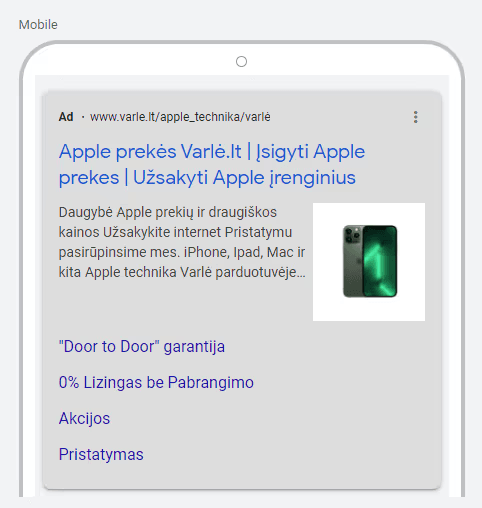

- Arranged additional links to actual pages with sales and special offers.
- Added data and structured descriptions of the unique selling propositions (USPs), including delivery options, prices, special offers, and product categories.
- Added sales extensions (the client now offers a variety of sales options on its site; the company did not previously used them in its ads).
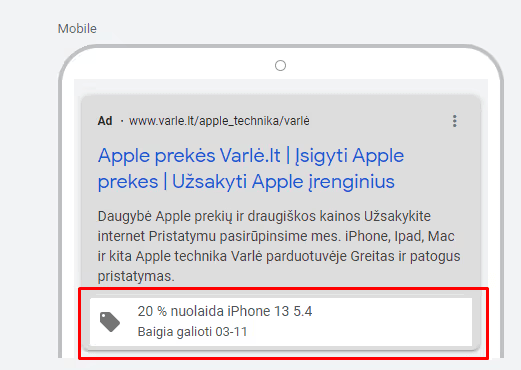
RESULTS IN NINE MONTH

Dynamic Search Ads (DSA) Segmentation
Dynamic Search Ads (DSA) 一 campaigns with dynamic search ads.
Problem
One of the tools that the client actively used was a dynamic search campaign (DSA). It was quite effective, as the site had good markup and was well optimized. However, this type of campaign had a significant drawback – setting the same bids for all products.
Example
A CPC of $0.01 was set for both the gift wrap and the iPhone XS. Since this rate for Apple equipment is uncompetitive, the bulk of the budget was spent on cheaper products, which affected the amount of the average check.
Solution

We:
- Discussed with the client the importance of distribution according to the marginality and profitability of product categories.
- Segmented product categories into separate ad groups with different rates for a separate product category.
- Processed the texts of the dynamic announcement.
- Boosted extensions with special and sales offers.
RESULTS IN NINE MONTHS

Turning to Automated Bid Setting Strategies
Since the main drawback of the advertising account was the lack of automation, its implementation became the key to increasing the effectiveness of all channels.
This decision was optimal because:
1. The main goal of business is to increase income.
2. It is important to maintain the return on investment in advertising.
3. The account is configured to transfer the purchase price, so you can adjust strategies based on income.
4. Manual bid adjustments take a lot of time. Optimizing demand bids for each item manually every hour is an impractical task within a client’s product catalog.
5. The data analysis process is simplified.
After completing the work on the correct filling of the campaigns (content for ads, keywords and negative words, setting the goals of “Sales”), the campaigns with the best results were gradually transferred to automatic strategies:
- Branded Campaigns
While competitors partially buy the branded queries of our client during the auctions, we re-settled the campaign toward the ‘Target Impression Share’ strategy by having purchased 100% impressions on the highest position in SERPs.
- Standard Trade Campaigns by Categories
Considering the outcomes of individual campaigns, we gradually transferred them to the ‘Maximize conversions bidding’ strategy (i.e. customer actions that convert to sales or service).
Campaigns that favored sales growth
⇓
“Target CPA bidding” or
“Target ROAS” Strategy
Campaigns with low average check
⇓
‘Max Conversion Value’ Strategy
- DSA Campaigns
Following the segmentation and processing through manual bids, the campaign stabilized and increased the average check. the stage ended with the transition to the automated strategy ‘Maximize conversions bidding’ with a follow-up transition to the «Max Conversion Value» bid, which allowed to increase the cost of the average check.
Launching Google Performance Max
Performance Max campaigns were launched with the goal for which the advertising account had already been optimized, 一 “Sales”. To date, this tool has successfully replaced Smart Shopping campaigns using a data feed that runs through Merchant Center in multiple countries.
Although commercial ads are still not available on the territory of Lithuania, the advertising campaign was launched with all possible basic settings for the main goal, but without a data feed. Performance Max can work effectively for search, contextual media and remarketing.
For the best purposes of the campaign, we opted for:
- Branded Varlė banners;


Banners with special and sales offers


- Ad texts with the best unique selling propositions (USPs);
- Extensions with the best unique selling propositions (USPs), sales and special offers.
Among possible settings, we opted for “Directing customers to the most relevant URL.” The approach enabled to target the campaign on all product items available on the client’s site.
As of now, the campaign features the lowest average check and the lowest СРА. Owing to the largest number of conversions, the campaign boosted the client’s revenue growth and overall profitability.
Launching Dynamic Remarketing
Given that the client used extended e-commerce options, we decided to launch dynamic remarketing through product feed as the ads for the campaign on the Google Display Network (GDN) that uses the feed to retrieve product data.
The approach differs from the standard setting of dynamic remarketing through Google Merchant Center; still, it is actual for the countries like Lithuania that lack trade advertising.
Outcomes
Within nine months, we managed to increase the client’s revenue by more than 1000%, excluding branded campaigns. The used tools helped us surge traffic, increase average check, CTR, CR and ROAS.
KEY RESULTS

Google Ads Script and Standard Search Campaigns
Automated suspension of ads activity for unavailable (out of stock) product items enabled us to increase ad relevance and enhance the quality of a customer’s “horizon of expectation” per the queried product.
Branded Campaigns
Our processing of branded campaigns considerably impacted the number of relevant search queries; we managed to outperform all the client’s competitors on the auctions per branded queries.
Automated Bidding Strategies
The transition to automated bidding strategies has proven as the most effective approach while it much favored the effectiveness of all client’s channels.
Segmentation of DSA Campaigns
An increase in relevant search queries has brought us ultimate auction wins per branded queries compared to the closest competitors.
Dynamic Remarketing
We managed to increase the number of the client’s returning visitors – the audience that surges transactions and repeated purchases.
Google Performance Max
Performance Max enabled to engage new users, boosted relevant traffic onto the client’s site, and led to the wider brand awareness. In this vein, we attribute the joint success to the client’s media network.
What’s Next?
Together with the client, we are going to:
- Develop dynamic remarketing;
- Process product feeds through the internal corporate service by Promodo 一 GYM to boost segmented activities and automize new product items in search;
- Increase Google Ads revenue;
- Expand media penetration to bring more new customers to the client’s site and incoming convert traffic into transactional;
- Track the activities related to the launch of Shopping campaigns in Lithuania.
